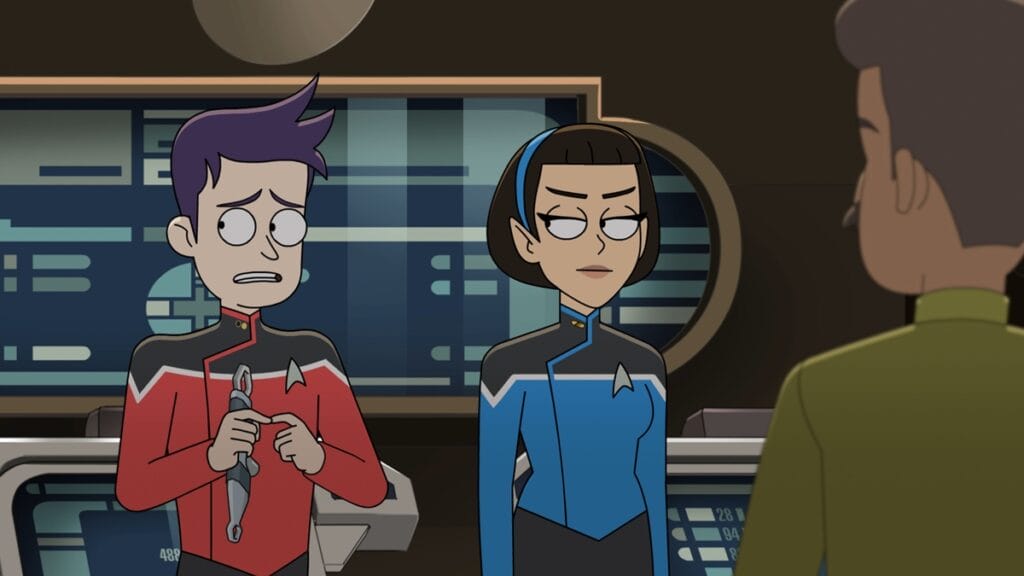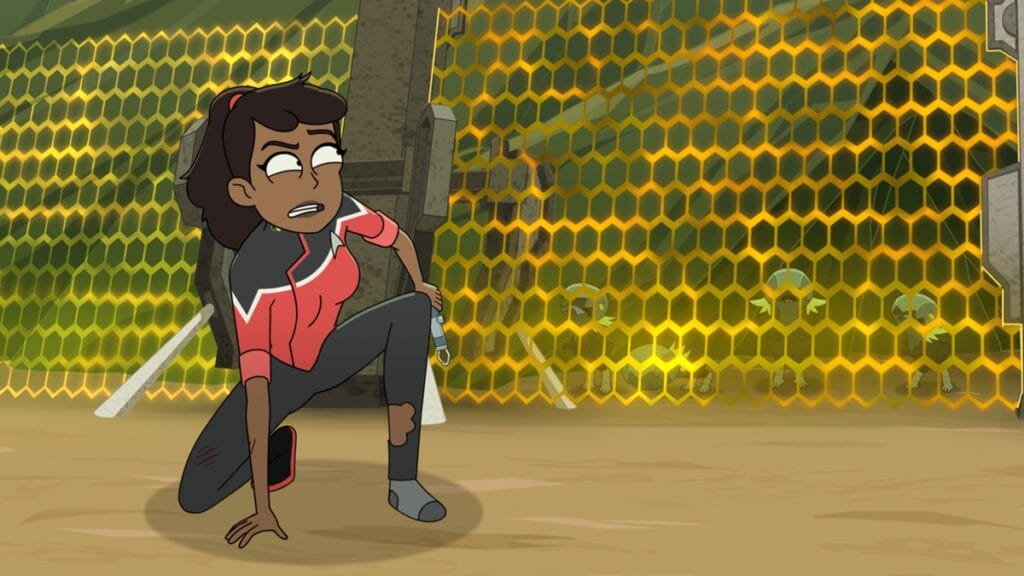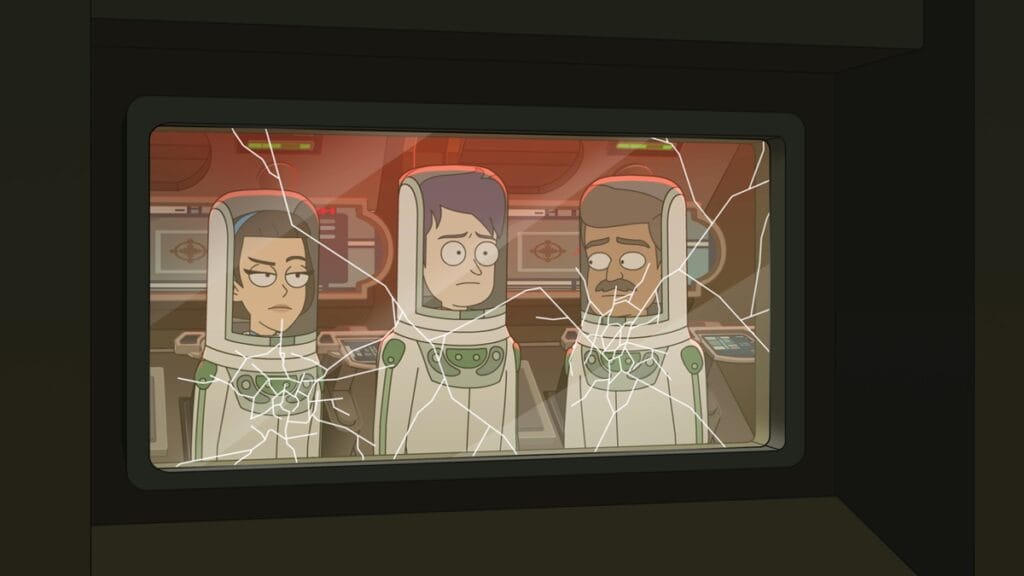Read also:
How to Watch FX Live Without CableHow To Watch AMC Without CableHow to Watch ABC Without CableHow to Watch Paramount Network Without Cable“The Inner Fight” channels trouble-making ensigns and cadets from Star Trek’s ago to explain Mariner’s current struggle.
This piece was written during the 2023 SAG-AFTRA strikes. Without the labor of the actors currently on strike, the works being covered here wouldn’t exist.
Lower Decks loves its obscure Star Trek references and major canon connections. So it’s a thrill, but not a surprise, when Captain Freeman (Dawnn Lewis) warns that the mysterious vessel that’s been absconding with entire ships this season is now kidnapping former members of Starfleet, to where the Federation must now protect famous faces like Seven of Nine, Beverly Crusher, and Thomas Riker. In the same way, it’s a laugh, but not a shock, when the Captain encounters what she thinks is Balok’s puppet from 1966’s “The Corbomite Maneuver” (even if she discovers, to her chagrin, that it is, in fact, a living, breathing creature).
And in a show that’s brought back one-hit wonders like Sonya Gomez and Leah Brahms, it’s exciting, but not unexpected, when the season’s ninth episode sends Freeman, Shax, and Rutherford (Eugene Cordero) off to a hive of scum and villainy to track down none other than Nicholas Locarno (Robert Duncan McNeill).
 Paramount+)" class="wp-image-44985"/>
Paramount+)" class="wp-image-44985"/>For the uninitiated, Locarno comes from “The First Duty,” a 1992 episode of The Next Generation. He’s a proto-Tom Paris who led the members of the famed “Nova Squadron” flight team (including none other than Wesley Crusher) through a dangerous stunt that got a classmate killed, Wesley reprimanded, and Locarno himself expelled from the Academy. Touching on whatever happened to the mendacious former cadet in the years since his disgrace is right up Lower Decks’ alley.
But what I admire about Lower Decks is that, like its crossover companion, the series doesn’t just invoke Star Trek’s history; it harnesses it to make meaning for this show and these characters. So after multiple episodes spent developing Mariner’s (Tawny Newsome) struggles this year, with Beckett herself not completely sure of the cause, “The Inner Fight” provides an answer. And, naturally, it includes a connection to something fans have already seen.
After attempting to earn a demotion or give into other forms of self-sabotage, Mariner has now resorted to acting dangerously cavalier in life-or-death situations. Given her recent predilections, and the show’s long-standing creative impulses, it’s no shock that her combative impulses lead her to challenge a Klingon or that he turns out to be Ma’ah, the Klingon lower decker we met back in season 2’s “wej Duj.”
[T]he series doesn’t just invoke Star Trek’s history; it harnesses it to make meaning for this show and these characters.
As with T’Lyn becoming a bigger part of the series, it’s nice to see Ma’ah have a key role to play here. The warriors’ duel between him and Mariner settles into a pair of kindred spirits confiding in one another amid challenging circumstances. Mariner feels like she can’t talk about what she’s going through with her friends. Still, Ma’ah walks the nice middle ground between being a fellow young officer who will get it, while also being a stranger who won’t care enough to give her grief (or, you know, survive if they restart the duel). So Ma’ah’s presence provides a nice excuse for Mariner to spill her guts about her central hang-up before trying to spill anyone else’s guts.
The explanation the episode offers for her inner struggle is simple but sad. The reason Mariner is so dead set against ranking up, so desperate to fall back down the ladder, is that her best friend from her Academy days never made it past “ensign” before she was tragically killed in action. Caring about someone, even loving them, and seeing their bright future snuffed out would undoubtedly leave a mark on your psyche. The idea that Mariner has survivor’s guilt, that she feels she doesn’t deserve to rise above the lowest rank in Starfleet if the universe wouldn’t let her best friend do the same, to where she’d rather die than live with that guilt, is a powerful reveal.
It is, also, kind of a cheat. We’ve never heard a peep about this uber-important friendship until now. The show has hinted at the reasons behind Beckett’s desire to stay an ensign before, and the clues suggested it had something to do with valuing her autonomy and wanting the leeway to be herself without senior officer expectations, with a dash of lingering issues between her and her parents. None of that seems to factor in here. True to Lower Decks’ 1990s Trek roots, this all-important bit of backstory comes out of nowhere.
 Paramount+)" class="wp-image-44984"/>
Paramount+)" class="wp-image-44984"/>And yet, it’s those 1990s Trek roots that help balance out this emotional shortcut. Because Mariner’s sadly departed best friend isn’t some random officer. She is, instead, Ensign Sito, who was part of the same infamous Nova Squadron that Nick Locarno led to disgrace and shame.
Despite Locarno’s expulsion, Sito herself persevered, eventually earning a posting on the Enterprise, the mentorship of Commander Worf, and the trust of the venerable Captain Picard in a later installment of TNG.
It’s a bold, creative choice to tie her and Mariner together. With that, the death of Beckett’s best friend becomes more than some tossed-off bit of dialogue. It comes with the resonance of a young officer willingly assuming a grave risk for the greater good to build bridges across species, proving herself worthy of the faith of her senior officers, and meeting a tragic end. And, not for nothing, her courageous sacrifice in The Next Generation just so happens to come in an episode titled “Lower Decks.”
After four seasons’ worth of stories, Star Trek: Lower Decks finally invokes the episode that provided its namesake and inspiration.
That’s right. After four seasons’ worth of stories, Star Trek: Lower Decks finally invokes the episode that provided its namesake and inspiration. It’s easy to forgive series creator Mike McMahan for taking a few liberties with Mariner’s personal history when he’s channeling the story of Star Trek’s original screw-up ensign made good to explain Mariner’s psychological hardship at the prospect of surpassing someone who meant the world to her. (Plus, hey, it doesn’t hurt that the death of a Bajoran like Sito deep in Cardassian territory helps explain Mariner’s time on Deep Space Nine.)
So it’s still fun to enjoy a comic relief B-story where Captain Freeman attempts to locate Locarno on “New Axton,” a bastion of non-conformists who thumb their noses at Federation superiority. Her exploits run into unexpected roadblocks when trying to hunt for information from locals, most of whom think Starfleet officers are arrogant pricks, are a laugh and a half. And the reveal that Captain Freeman was deliberately running a smokescreen for the grisly bounty hunter who’s one-upped them the whole way, who turns out to be Billups in disguise, is a winning twist.
Likewise, it’s still exciting to see some payoff to the ongoing storyline of the mysterious ship abducting people from across the galaxy. Seeing the assembled Romulans, Ferengi, Bynars, Cardassians, and Orions rumbling around on Sherbal V adds to the mystery and the cool factor of their peculiar kidnapping plot. The fact that Mariner finds herself in the middle of the skirmish but cools them down and convinces them to cooperate for the greater good not only does a superb job of dramatizing Mariner having overcome her mental block through her conversation with Ma’ah but shows her honoring the pure Starfleet spirit of her dearly departed friend.
 Paramount+)" class="wp-image-44982"/>
Paramount+)" class="wp-image-44982"/>That spirit may, in a strange way, be the same thing that’s motivating the season’s apparent villain. In the episode’s biggest reveal, it is, in fact, Nick Locarno himself who’s behind the strange vessel and its sneaky abductions. Hearing McNeill reprise the role for the first time in more than thirty years is a treat. His rule-bending (and breaking) streak makes him a natural counterpart to Mariner, especially with the implication that they, too, may have some shared history. And for a character who was drummed out of Starfleet before his career even started and saw his friend die in the service, his disruptive actions may be as much spurred by Sito’s memory as Mariner’s were.
That is the benefit of utilizing Star Trek’s past rather than just parading around references for recognition and amusement. The approach allows you to tie your stories, your characters, to a wider tapestry of events and triumphs and sacrifices that help add meaning by a connection to a greater whole. Mariner has been struggling all season. Now, we finally know why, and it’s because of her bond with a fellow lower decker, who the audience knows will never be able to fly as high. To embrace that, to use it as fuel for Becket’s struggle and breakthrough, does justice to what came before, and paves the way for Mariner’s brighter future.